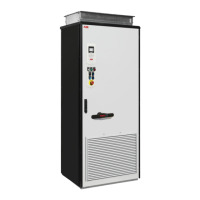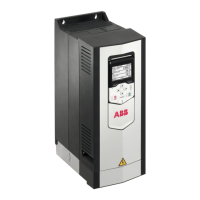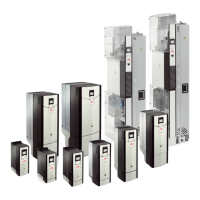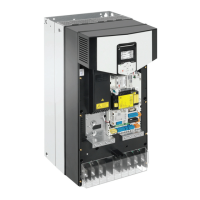Do you have a question about the ABB ACS880-07XT Series and is the answer not in the manual?
Explains warning symbols and notes used in the manual for hazard identification.
Provides essential safety guidelines for handling and installing the drive module.
Details safety measures for electrical work during installation and maintenance.
Lists critical steps to ensure safety before commencing any electrical work.
Covers extra safety instructions, including handling ESD-sensitive components.
Explains the importance and methods for proper grounding of the drive.
Provides specific safety instructions for drives with permanent magnet motors.
Defines the intended readers and the manual's coverage of drive installation and use.
Briefly describes the content and organization of the manual's chapters.
Lists other relevant ABB manuals for additional information and support.
Explains how frame sizes and option codes are used to identify drive configurations.
Introduces the ACS880-07XT drive, its purpose, and main components.
Presents a schematic illustrating the main functional blocks of the drive.
Details the 12-pulse connection option (+A004) and its benefits.
Shows typical cabinet configurations and internal component layouts.
Illustrates the drive's power connections and control interface layout.
Describes the function of door-mounted switches and status indicator lights.
Explains the operation and function of the main disconnecting device (Q1.1).
Covers the ACS-AP-I control panel and connection for PC-based control.
Guidelines for selecting and preparing a suitable installation site for the drive.
Lists required tools and procedures for checking the received drive delivery.
Instructions for safely moving and unpacking the drive cabinet.
Procedures for lifting the unpacked cabinet using cranes or other equipment.
Guidance on positioning and securely fastening the cabinet to the floor or wall.
Details on different methods for securing the drive cabinet.
Specific instructions for fastening cabinets intended for marine environments.
Covers additional mechanical considerations like cable ducts and floor requirements.
Guidance on selecting appropriate disconnecting devices for AC power sources.
Criteria for selecting a main contactor based on drive specifications.
Ensuring compatibility between the selected motor and the drive unit.
Measures to protect motor insulation and bearings from drive-related stresses.
A table detailing insulation systems and filters required for various motor types.
Specific requirements for high-output and IP23 rated motors.
Data for calculating voltage rise time and peak line-to-line voltage based on cable length.
Guidelines for selecting, routing, and shielding power cables for optimal performance.
Recommendations for selecting, routing, and shielding control cables.
Details on cable shielding requirements and proper routing techniques.
Instructions for protecting the drive, cables, and motor against thermal and short-circuit faults.
How to implement motor thermal protection using drive features or sensors.
Information on the drive's internal ground fault protection function.
Guidance on implementing the emergency stop function using Safe Torque Off.
Instructions and considerations for implementing a bypass connection with contactors.
Safety warnings and procedures for checking electrical insulation of the drive and cables.
Ensuring compatibility when connecting the drive to IT (ungrounded) systems.
Detailed steps for connecting and grounding control cables to the drive.
Instructions for wiring the control unit (A41) and auxiliary terminal blocks.
Wiring the external 230/115 V AC auxiliary voltage supply (UPS, option +G307).
Connecting external emergency stop push buttons according to circuit diagrams.
Connecting power wires for the auxiliary motor fan (options +M602…+M610).
Instructions for wiring thermistor (+L505) and Pt100 (+L506) relay options.
Procedures for connecting motor cables, with and without du/dt terminals.
Connection diagrams and procedures for input power cables (6-pulse and 12-pulse).
Steps for connecting a PC to the drive for configuration and monitoring.
Guidance on the mechanical installation of various option modules.
General safety warnings to be observed before starting the drive installation.
A comprehensive checklist of items to verify before drive start-up.
Introduction to the start-up process and essential safety precautions.
Steps to verify settings and connections before applying power.
Procedure for safely powering up the drive's auxiliary circuits.
Configuring supply unit voltage and main fan fault parameters.
Steps for configuring drive parameters and performing the initial start-up.
Procedure for powering the main circuit and performing checks under load.
Description of the status LEDs on the control panel and control unit.
Information on interpreting and resolving drive control program warnings and faults.
Table outlining recommended maintenance tasks and intervals.
Instructions for cleaning the interior and air inlets of the drive cabinet.
Procedures for cleaning heatsinks and replacing cooling fans.
Step-by-step guide for replacing drive modules (right and left).
Information on capacitor reforming and control panel battery replacement.
Guidance on BCU control unit types, memory units, and control unit battery.
Procedures for starting and resuming normal operation in reduced run mode.
Detailed ratings for drive modules, including output and input current.
Information on how ambient temperature and altitude affect drive performance.
Drive ratings when high speed mode is enabled for output frequencies above 120 Hz.
Details on frame sizes, power modules, and recommended IEC aR fuses.
Data on physical dimensions, heat dissipation, noise levels, and free space requirements.
Specifications for the electrical power network and motor connection parameters.
List of relevant standards and specifications for tightening electrical and mechanical connections.
Explanation of EMC terms and categories (C2, C3, C4) for drive applications.
Provides dimensions and approximate weights for cabinet line-ups.
Illustrative drawings showing cabinet dimensions and layouts.
Diagrams showing the location of input, output, and PE terminals.
Describes how brake choppers and resistors work and how to plan their selection.
Guidelines for selecting custom brake resistors based on resistance and load capacity.
Instructions for selecting, routing, and minimizing interference for brake resistor cables.
Guidance on placing resistors and protecting the system against thermal overload.
Steps for electrical installation, connection, and start-up of external brake resistors.
Explains warning symbols and notes used in the manual for hazard identification.
Provides essential safety guidelines for handling and installing the drive module.
Details safety measures for electrical work during installation and maintenance.
Lists critical steps to ensure safety before commencing any electrical work.
Covers extra safety instructions, including handling ESD-sensitive components.
Explains the importance and methods for proper grounding of the drive.
Provides specific safety instructions for drives with permanent magnet motors.
Defines the intended readers and the manual's coverage of drive installation and use.
Briefly describes the content and organization of the manual's chapters.
Lists other relevant ABB manuals for additional information and support.
Explains how frame sizes and option codes are used to identify drive configurations.
Introduces the ACS880-07XT drive, its purpose, and main components.
Presents a schematic illustrating the main functional blocks of the drive.
Details the 12-pulse connection option (+A004) and its benefits.
Shows typical cabinet configurations and internal component layouts.
Illustrates the drive's power connections and control interface layout.
Describes the function of door-mounted switches and status indicator lights.
Explains the operation and function of the main disconnecting device (Q1.1).
Covers the ACS-AP-I control panel and connection for PC-based control.
Guidelines for selecting and preparing a suitable installation site for the drive.
Lists required tools and procedures for checking the received drive delivery.
Instructions for safely moving and unpacking the drive cabinet.
Procedures for lifting the unpacked cabinet using cranes or other equipment.
Guidance on positioning and securely fastening the cabinet to the floor or wall.
Details on different methods for securing the drive cabinet.
Specific instructions for fastening cabinets intended for marine environments.
Covers additional mechanical considerations like cable ducts and floor requirements.
Guidance on selecting appropriate disconnecting devices for AC power sources.
Criteria for selecting a main contactor based on drive specifications.
Ensuring compatibility between the selected motor and the drive unit.
Measures to protect motor insulation and bearings from drive-related stresses.
A table detailing insulation systems and filters required for various motor types.
Specific requirements for high-output and IP23 rated motors.
Data for calculating voltage rise time and peak line-to-line voltage based on cable length.
Guidelines for selecting, routing, and shielding power cables for optimal performance.
Recommendations for selecting, routing, and shielding control cables.
Details on cable shielding requirements and proper routing techniques.
Instructions for protecting the drive, cables, and motor against thermal and short-circuit faults.
How to implement motor thermal protection using drive features or sensors.
Information on the drive's internal ground fault protection function.
Guidance on implementing the emergency stop function using Safe Torque Off.
Instructions and considerations for implementing a bypass connection with contactors.
Safety warnings and procedures for checking electrical insulation of the drive and cables.
Ensuring compatibility when connecting the drive to IT (ungrounded) systems.
Detailed steps for connecting and grounding control cables to the drive.
Instructions for wiring the control unit (A41) and auxiliary terminal blocks.
Wiring the external 230/115 V AC auxiliary voltage supply (UPS, option +G307).
Connecting external emergency stop push buttons according to circuit diagrams.
Connecting power wires for the auxiliary motor fan (options +M602…+M610).
Instructions for wiring thermistor (+L505) and Pt100 (+L506) relay options.
Procedures for connecting motor cables, with and without du/dt terminals.
Connection diagrams and procedures for input power cables (6-pulse and 12-pulse).
Steps for connecting a PC to the drive for configuration and monitoring.
Guidance on the mechanical installation of various option modules.
General safety warnings to be observed before starting the drive installation.
A comprehensive checklist of items to verify before drive start-up.
Introduction to the start-up process and essential safety precautions.
Steps to verify settings and connections before applying power.
Procedure for safely powering up the drive's auxiliary circuits.
Configuring supply unit voltage and main fan fault parameters.
Steps for configuring drive parameters and performing the initial start-up.
Procedure for powering the main circuit and performing checks under load.
Description of the status LEDs on the control panel and control unit.
Information on interpreting and resolving drive control program warnings and faults.
Table outlining recommended maintenance tasks and intervals.
Instructions for cleaning the interior and air inlets of the drive cabinet.
Procedures for cleaning heatsinks and replacing cooling fans.
Step-by-step guide for replacing drive modules (right and left).
Information on capacitor reforming and control panel battery replacement.
Guidance on BCU control unit types, memory units, and control unit battery.
Procedures for starting and resuming normal operation in reduced run mode.
Detailed ratings for drive modules, including output and input current.
Information on how ambient temperature and altitude affect drive performance.
Drive ratings when high speed mode is enabled for output frequencies above 120 Hz.
Details on frame sizes, power modules, and recommended IEC aR fuses.
Data on physical dimensions, heat dissipation, noise levels, and free space requirements.
Specifications for the electrical power network and motor connection parameters.
List of relevant standards and specifications for tightening electrical and mechanical connections.
Explanation of EMC terms and categories (C2, C3, C4) for drive applications.
Provides dimensions and approximate weights for cabinet line-ups.
Illustrative drawings showing cabinet dimensions and layouts.
Diagrams showing the location of input, output, and PE terminals.
Describes how brake choppers and resistors work and how to plan their selection.
Guidelines for selecting custom brake resistors based on resistance and load capacity.
Instructions for selecting, routing, and minimizing interference for brake resistor cables.
Guidance on placing resistors and protecting the system against thermal overload.
Steps for electrical installation, connection, and start-up of external brake resistors.
| Series | ACS880-07XT |
|---|---|
| Category | DC Drives |
| Storage Temperature Range | -40 to +70 °C |
| Input Voltage | 380 V to 690 V |
| Output Voltage Range | 0 V to Input Voltage |
| Voltage | 380 V to 690 V |
| Control Method | Vector control |
| Cooling Method | Air cooled |
| Protection Class | IP21, IP54 |
| Enclosure Class | IP00, IP20, IP21, IP42, IP54 |
| Communication Options | Ethernet, Modbus, Profibus, CANopen |
| Relative Humidity | 5 to 95%, non-condensing |











